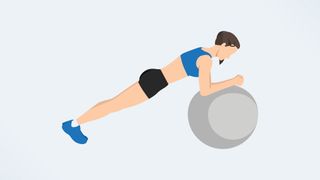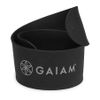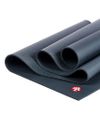
Planks are a staple bodyweight exercise, but if, for whatever reason, you struggle to perform them on the ground, try the “stir the pot” abs exercise instead.
Using a stability ball, you can crank up the intensity on your core muscles while holding a forearm plank position on an incline. The move tests shoulder and core stability and balance, strengthening the same muscles as your standard plank.
Can’t do planks? Here’s how to stir the pot instead and reasons you should consider giving it a try.
What is the “stir the pot” plank exercise?
Perform a forearm plank with your elbows supported on a stability ball, also known as a Swiss ball, and the balls of your feet resting on the ground. From here, begin drawing circles with your elbows in clockwise and counterclockwise directions — “stirring the pot.”
If you’ve ever used a stability ball before, it’s ironic, considering how unstable the ball is to work with. But that instability will improve balance, coordination and strength as your core muscles work to resist motion and keep you positioned on the ball.
How to do the stability ball “stir the pot” core exercise

First, grab a stability ball and place it in front of you, then follow these steps:
- Place your elbows on the ball beneath your shoulders. Press down
- Step back into a plank position and rest on the balls of your feet
- Squeeze your stomach, glutes, and quads and keep your shoulders over your elbows
- Create circles with your elbows moving clockwise and counterclockwise with slow control.
Although you’re looking for rotation of the ball, your core must work to resist rotation of the rest of your body or losing control of the ball. It’s a brilliant anti-rotation and anti-extension exercise and an efficient core-strengthener.
Sign up to get the BEST of Tom's Guide direct to your inbox.
Here at Tom’s Guide our expert editors are committed to bringing you the best news, reviews and guides to help you stay informed and ahead of the curve!
Benefits of the stability ball “stir the pot” core exercise
Your entire network of core muscles works hard to keep you stable during this exercise, including your abs, obliques, deeper transverse abdominal muscles, glutes and hip flexors. The plank variation also hits your shoulders, chest, lower back and quads.
But this isn’t just about your big and powerful muscle groups, it’s about muscles big and small, including the lesser-known stabilizer muscles that recruit alongside the main drivers.
Think about the muscles surrounding your spine and pelvis that support movement and act as injury prevention. Essentially, these muscles keep your lower body stable. When they’re strong, your torso is too. Your body can withstand, endure and control. We should all be aiming toward bulletproofing the core, as your ability to resist unwanted movement and outside force comes from these powerhouse muscles.
Adding anti-rotation exercises like this or the Pallof press helps train core strength and activates the deep core muscles, which are crucial for stabilization and form. Stir the pot planks also require a neutral spine, meaning you’ll work to keep your hips aligned with your shoulders rather than dropping them toward the floor. Learning to prevent hyperextension is also crucial for optimal back health.
Think about the muscles surrounding your spine and pelvis that support movement and act as injury prevention. Essentially, these muscles keep your lower body stable. When they’re strong, your torso is too.
It’s all about protecting your spine, so while performing this exercise, there are a few tips I recommend for perfecting your plank form. First, keep your hips up — sagging puts more strain on your lower back, increasing the likelihood of injury. Use conscious contraction (squeezing the muscle groups mentioned above) to keep your body in the plank position.
Next, start with small circles and build as you learn to maintain control. Practice slightly tucking your pelvis and pulling your shoulder blades apart to create a soft hollow. Finally, move slowly, feeling the muscles working rather than allowing speed to take over.
I recommend working for time, starting with 3-5 sets of 20 seconds and resting for 20 seconds. Add time as you get stronger and more confident. You could also mix some Swiss ball planks and work between moving and static exercises as part of a core-strengthening superset.
More from Tom's Guide
- I'm a personal trainer — the candlestick roll is the best bodyweight exercise for your barbell squats
- I did 70 decline push-ups every day for a week — here’s what happened to my upper body
- Pilates instructor shares 3 favorite moves for strengthening your back and boosting posture — and 3 common mistakes

Sam Hopes is a level 3 fitness trainer, level 2 reiki practitioner, and senior fitness writer at Tom's Guide. She is also currently undertaking her Yoga For Athletes training course.









